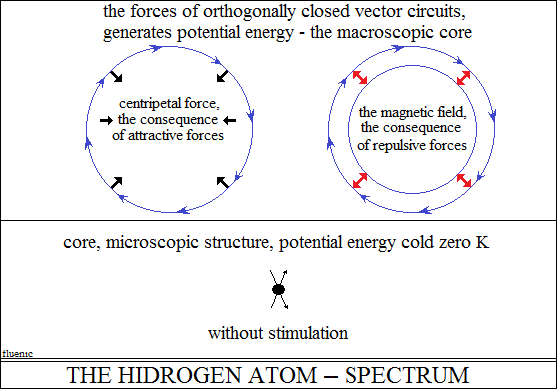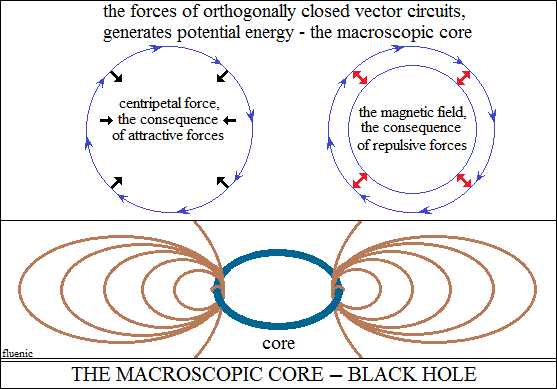- White - Black -
- Hot - cold -
Kinetic energy - potential energy.
Energy is the interaction of vector properties, which generated matter.
For the
materialist conception, energy is a state function, a scalar measure of
matter's
movement. Definition absurd! What moves matter? The energy! No, matter
does
not produce energy, but vice versa, energy produces matter and movement!
The perception of energy by the sense organs, from the frequency spectrum:
The visual organ perceives the vector oscillations, the kinetic energy,
like a white
color. The structure of the visual organ evolved from exposure to the
resonance
of atoms with certain frequencies, for which they received the name of
the
optical spectrum. In some species of animals, the visual organs have evolved
from sensitivity to resonance with the frequencies of the environment
in which
they live. The kinetic state of energy is in agreement with the frequency
spectrum and decreases to zero oscillations, to the potential state of
energy.
In orthogonal circuits, the kinetic and potential energy states oscillate.
For all animals, the visual perception of potential energy is black, free
of
oscillations. For the tactile organ, kinetic energy is the sensation of
heat,
potential energy being the sensation of cold. Hot and cold is the measure
of
the variation of the wavelengths of the atomic spectra, from the kinetic
state
to the potential energy state, at zero Kelvin. Temperature, space, time,
force,
pressure, electricity, magnetism, etc., are mysteries for the materialist
conception!
These phenomena being energy, for each phenomenon, material particles
in
motion were invented, faithful to the materialistic definition of energy,
harmful to human reason. The structure of the tactile organ evolved, in
turn,
from the sensitivity to resonance with the frequencies of the surrounding
environment. Orthogonally closed macroscopic vector circuits (electromagnetic)
are the interactions of kinetic and potential states of energy, of attractive
and
repulsive forces. Visually, a star is a sphere of light, but measuring
instruments
detect a huge magnetic field. The magnetic field is one of the vector
circuits,
which orthogonally surround the electric circuit, the core of the star.
The orthogonal circuits interact with each other, through the vector properties
of attraction and repulsion between their multiple parallel circuits.
The force
of attraction from orthogonally closed circuits shortens the length of
the circuit,
increasing the density, the intensity. Consequently, the orthogonal circuits
they shrink towards the center, one around the other - the centripetal
force.
The repulsive forces from an orthogonal circuit, which completely surrounds
the other circuit, is called a magnetic field, the surrounded circuit
being called
an electric circuit. The electric circuit is compressed both by its own
attractive
forces and by magnetic attractive forces, stronger than the repulsive
forces
in the electric circuit. The huge pressure of the orthogonal vector forces
on
the electric circuit, transforms it into a solid core, without oscillations,
so zero Kelvin and black color. The nucleus is the immense potential energy
("massa" of Newton), which is visible in the universe, under
the name of black
energy, or black hole. The forces of repulsion spatially dilate the magnetic
circuits, being compressed only in the center of the electric circuit,
where
they form the magnetic axis and magnetic poles. Due to the vector pressure,
the open vector circuits of the magnetic poles produce substance jets,
colored
radiation and other phenomena. The forces of repulsion between the polar
open circuits, direct their propagation to long distances, where they
close,
giving the magnetic field a lenticular shape. Closed magnetic circuits
string
polarities of atoms, like on a compass needle, and the centripetal force
takes
them to the nucleus, forming the sphere of luminous plasma. The circular
movement of the magnetic field from the poles to the equator and back
to the
poles is a kinetic state of energy, which flows continuously, without
oscillations.
The continuous concentration of magnetic field energy produces three phenomena:
1) produces the huge vector pressure, which transforms the kinetic
structure of magnetism into the potential structure of the electric core.
2) The substance opposes the passage of the magnetic field,
a phenomenon called weight.
3) The magnetic field, passing through the substance, polarizes it electrically,


